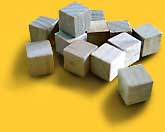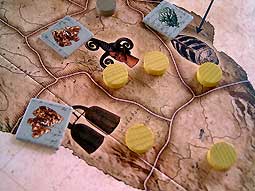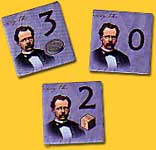Heart of Africa
Author: Andreas Steding
Publisher: Phalanx Games
Year: 2004
review by

| x |
|
|
|
|
|
|
|
|
|
|
|
|
|
|
|
|
|
|
|
|
|
|
|
|
|
|
 |
|
Africa is a large continent, and it may not be surprising that the board on which the game is played has large measurements too. In up to 25 regions we are about to battle for power, handed out as points needed for victory. Twelve of the regions are marked by symbols; resource chips are put there randomly. These resources can bring a variable amount of victory points for a player in his turn. Neutral traders are also placed there. Then each player chooses a coastal region as his starting point for his five traders from which he will try to expand, maybe as deep as the heart of Africa that will earn him additional points. The game is over when a player has reached or exceeded the rather strange amount of 42 points; this player has won the game. |
| x |
|
|
|
|
|
|
|
|
|
|
|
|
|
|
|
|
|
|
|
|
|
|
|
|
|
|
| Each player has an initial amount of bidding cubes that are part of a closed money system. According to imperialistic and capitalistic ventures, only the highest bidder in a round may perform a turn starting with taking the first two from six chips. These chips come with action points, needed to pay placement of new traders and moving them to neighbouring regions. |
 |
  |
|
The bidding starts with the player who has the highest score, and then moves downwards. Every player may only call one bid; he will consider how much he wants to pay to perform a turn. If his bid is too low, then an other player will take a turn. If his bid is too high, then he won’t be able to participate in future biddings for a couple of rounds, effectively being out of the game. It can be very frustrating for a player having to look at other active players, meanwhile only slowly recovering from his last purchase. |
| x |
|
|
|
|
|
|
|
|
|
|
|
|
|
|
|
|
|
|
|
|
|
|
|
|
|
|
| When performing his turn, a player starts with placing an additional neutral trader in an empty region or one that has already neutral traders in it. After he has taken all his action points in moving his own traders, and maybe taken one of the special functions a chip can have, he completes his turn by taking points for his presence in regions. Every neutral trader in his region reduces his score by one; they are not yet subdued or christened, or negotiations are still in progress so they still remain a nuisance, so to speak. |
|
 |
| x |
|
|
|
|
|
|
|
|
|
|
|
|
|
|
|
|
|
|
|
|
|
|
|
|
|
|
 |
The subjucation of neutral traders is relatively simple, game wise: the minimal condition is that a player must equal or outnumber the other traders in the region. To resolve this conflict, a conflict chip is drawn blind from a cup that indicate what will happen; these vary from taking away a number of own traders, to lowering your reputation on the reputation track. When battling other players traders in a region, a player must achieve more battle points in order to win. Every player counts his traders and multiplies it with the hight of his reputation. To this, he can secretly add one or more bidding cubes (worth 3 points), or unplayed action chips (a whopping 9 point each). |
| x |
|
|
|
|
|
|
|
|
|
|
|
|
|
|
|
|
|
|
|
|
|
|
|
|
|
|
| Players reveal their bid simulteneously; the highest score wins. The loser must take away one of his traders, and the winner may retreat all other traders one or two regions, even to different ones! This is a great opportunity for a victor to scatter the defeated troops even more, thereby nullifying the threat of a possible counter attack. |
|
 |
| x |
|
|
|
|
|
|
|
|
|
|
|
|
|
|
|
|
|
|
|
|
|
|
|
|
|
|
 |
At the end of a turn two new action chips are drawn blind. In this way, players always have an insight on the actions that are to come and will be auctioned with the inevitable pros and contras: does one bid on a weaker pair, and be able to perform a turn, or does one wait until the highly valued and most wanted pair comes into play, knowing that for this set an initial higher bid will have to be made, and, maybe worse, that one will get overbid and will not get any turn to make at all? |
| x |
|
|
|
|
|
|
|
|
|
|
|
|
|
|
|
|
|
|
|
|
|
|
|
|
|
 |
| x |
|
|
|
|
|
|
|
|
|
|
|
|
|
|
|
|
|
|
|
|
|
|
|
|
|
 |
|
|
|
|
|
|
|
|
|
|
|
|
|
|
|
|
|
|
|
|
|
 |
|
|
|
|
|
|
|
|
|
|
|
|
|
|
|
|
|
|
|
|
|
 |
|
|
|
|
|
|
|
|
|
|
|
|
|
|
|
|
|
|
|
|
|
| x |
|
|
|
|
|
|
|
|
|
|
|
|
|
|
|
|
|
|
|
|
|
|
|
|
|
 |
|
|
|
|
|
|
|
|
|
|
|
|
|
|
|
 |
|
|
|
|
|
|
|
|
|
|
|
|
|
|
|
|
|
|
|
|
|
|
|
|
|
|
|
|
|
|
|
|
|
|
|
|
|
|
|
|
|
|
|